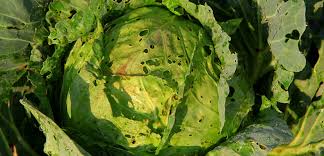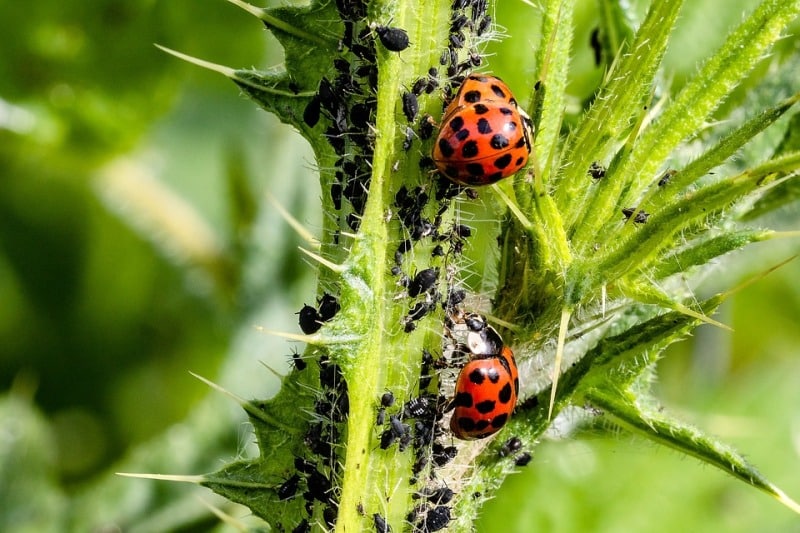The range of pests and diseases that can damage vegetables is immense, but specific ones that significantly affect productivity in a given region are usually limited.
Pests and diseases may be soil-borne or air-borne and can be crop-specific or generic, so the range of potential control measures is vast. However, several basic principles can be applied to reduce their impact on yield and quality.
The first principle is crop hygiene, which involves the sound agronomic practice of not growing the same crop on the same site year after year. Crop rotation reduces the risk of buildup of soil-borne pathogens.
The second principle is to use only ‘pathogen-free’ planting material. This ensures the use of healthy planting material. Using resistant varieties is an efficient method of reducing pathogen impact on the crop where suitable varieties are available.
Next is biological control, which reduces pest populations through natural enemies or environmental factors. Although biological control requires knowledge specific to local environmental conditions and is labor intensive, it provides sound economic returns.
Pesticides remain the most common method for controlling pests and diseases in vegetable crops despite concerns about safety and pesticide resistance development.
Recently, the development of Integrated Pest Management (IPM) systems has reduced the need for regular pesticide use. IPM combines practical methods with detailed knowledge of pest life cycles and their interaction with the environment.
This approach manages pest damage with minimal hazards to the environment and people, and by the most economical means. IPM consists of pest management evaluation, decision-making, and control measures.
Read Also: Options for Genetic Improvement in Tropical Livestock
Pest and Disease Control Principles in Crop Production

Pests and diseases are natural components of farming ecosystems. Ideally, a natural balance exists between predators and pests. When this balance is disrupted, one population may become dominant due to the lack of natural enemies.
Natural control aims to restore this balance and maintain pest and disease levels at an acceptable threshold. The goal is not eradication but control to prevent economic loss. The following principles assist in reducing their impact on yield and quality:
A. Natural Pest and Disease Control Methods for Organic Farming
Organic farmers can use several methods to control pests and diseases, including:
1. Growing healthy crops: Healthy crops suffer less damage.
2. Choosing resistant crop varieties: Local varieties generally resist local pests better than introduced ones.
3. Timely planting: Planting at times that avoid peak pest activity reduces damage.
4. Companion planting: Using crops such as onion or garlic that pests avoid.
5. Pest trapping or manual removal: Collecting pests physically reduces their numbers.
6. Correct identification of pests and diseases: Prevents unnecessary elimination of beneficial insects.
7. Crop rotation: Breaks pest cycles and prevents carryover to subsequent seasons.
8. Providing natural habitats: Encourages predators that control pests.
Careful planning and the use of these techniques can often eliminate the need for chemical sprays. If pests persist, natural products such as sprays made from chillies, onions, garlic, or neem can manage infestations.
Pest Management Techniques in Organic Crop Production
Since synthetic chemicals are prohibited in organic farming, pest management relies on:
(i) Cultural or agronomic methods
(ii) Mechanical control
(iii) Biological control
(iv) Organically acceptable botanical extracts and some chemicals like copper sulphate and soft soap
1. Cultural Control or Crop Hygiene Practices
Crop hygiene involves avoiding repeated planting of the same crop or related crops on the same land. Ideally, crops from the same family should not be grown more than once every three years on the same site.
Crop rotation reduces the buildup of soil-borne pathogens. Examples include controlling clubroot in cabbages and nematodes in carrots.
Using disease-free seed or stock and resistant varieties are important preventive measures in organic pest management.
Biodiversity maintenance, effective crop rotation, multiple cropping, habitat manipulation, and trap cropping help keep pest populations below economic threshold levels (ETL).
2. Mechanical Control Methods for Pest Management
Mechanical methods include removing affected plants and plant parts, destroying egg masses and larvae, and using bird perches, light traps, sticky colored plates, and pheromone traps. These approaches are effective in reducing pest populations without chemicals.
3. Biological Control Methods for Pest Management
Biological control reduces pest populations by conserving natural enemies such as lady beetles and lacewings. Plants like sage can deter pests such as cabbage moths and carrot flies.
Though labor intensive and environment-specific, biological control provides good economic returns, with cost-benefit ratios reported as high as 1:11.
The use of pest predators and pathogens effectively keeps pest problems below ETL. Releases of beneficial insects like Trichogramma, Chelonus blackburni, Apanteles, and Chrysoperla after sowing can significantly control pests in organic farming.
Read Also: All You Need To Know About Animal Shelters
Use of Biopesticides in Organic Farming

Biopesticides such as Trichoderma viride, T. harazianum, or Pseudomonas fluorescens at 4 gm/kg seed manage many seed-borne and soil-borne diseases.
Other formulations like Beauveria bassiana, Metarhizium anisopliae, Nomuraea rileyi, and Verticillium species are available to target specific pests. Bacillus thuringiensis strains control coleopterans and other insects, including diamondback moth on crucifers, applied at 0.5–1.0 kg/ha.
Viral biopesticides from baculovirus groups, such as granulosis viruses (GV) and nuclear polyhedrosis viruses (NPV), offer effective control of pests like Helicoverpa armigera and Spodoptera litura at recommended larval equivalents.
Botanical Pesticides Used in Organic Crop Protection
Many plants possess pesticidal properties, and extracts or refined forms can be used in pest management. Among these, neem is the most effective botanical pesticide.
1. Nicotine: Derived from tobacco (Nicotiana species), nicotine is a traditional insecticide but is highly toxic to warm-blooded animals and absorbs readily through the skin.
2. Sabadilla: Extracted from sabadilla lily seeds, containing veratrine alkaloid. It has low toxicity but can irritate eyes and respiratory passages when inhaled as dust.
3. Neem: Extracted from the neem tree native to India, neem contains compounds like salannin and azadirachtin with insecticidal activity and fungicidal properties. It controls pests such as gypsy moths, thrips, whiteflies, leaf miners, caterpillars, and mealybugs.
Other Organic Pest Control Formulations
Numerous innovative formulations developed by organic farmers and NGOs are widely used despite limited scientific validation. These formulations can be prepared on the farm without purchase, promoting accessibility and sustainability. Some popular examples include:
1. Cow urine: Diluted 1:20 with water and used as foliar spray, it manages pathogens and insects and promotes crop growth.
3. Fermented curd water: Used in some regions for controlling whiteflies, jassids, and aphids.
4. Dashparni extract: A complex ferment involving neem, vitex, papaya, custard apple, and other leaves, mixed with cow dung and urine, ferments for a month and is effective for one acre.
5. Neem-cow urine extract: Fermented mixture of neem leaves, cow urine, and dung diluted for foliar spray, effective against sucking pests and mealybugs.
6. Mixed leaves extract: Boiled and fermented combination of neem, custard apple, papaya, pomegranate, and guava leaves with cow urine, stored for six months and used as foliar spray.
7. Chilli-garlic extract: Boiled mixture of Ipomea leaves, hot chili, garlic, and neem leaves in cow urine, diluted for spray against leaf rollers and borers.
8. Broad-spectrum formulation: A mixture of neem leaves and seed kernel powder with cow urine, prepared in a copper container, acts as a wide-range pest control.
Do you have any questions, suggestions, or contributions? If so, please feel free to use the comment box below to share your thoughts. We also encourage you to kindly share this information with others who might benefit from it. Since we can’t reach everyone at once, we truly appreciate your help in spreading the word. Thank you so much for your support and for sharing!

